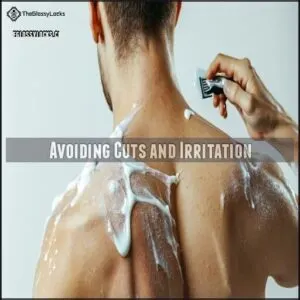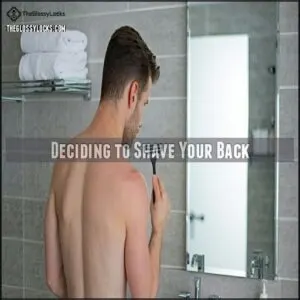This site is supported by our readers. We may earn a commission, at no cost to you, if you purchase through links.

Trim any long hair first to prevent clogging the blade. Hop in a warm shower to soften hair and open pores, then apply a generous layer of shaving gel for smooth gliding.
Use mirrors to map out your progress, and shave in small sections following the hair’s grain. Rinse the blade often to avoid buildup.
Once you’re done, rinse your back, pat it dry, and apply moisturizer to keep skin happy. Curious about alternative methods? Stay tuned.
Table Of Contents
- Key Takeaways
- Preparing for Back Shaving
- How to Shave Your Back Properly
- Mastering Back Shaving Techniques
- Post-Shave Care and Skin Health
- Alternative Hair Removal Methods
- Deciding to Shave Your Back
- Maintaining Healthy Skin After Shaving
- Frequently Asked Questions (FAQs)
- How can I shave my back by myself?
- Is it a good idea to shave your back?
- What is the best way to remove hair from your back?
- How to shave hair in the back?
- How to shave backside hair?
- How to shave your back?
- How do you treat a razor bump in women?
- Should you shave your back first?
- How do you shave back hair?
- Is it necessary to shave back hair?
- Conclusion
Key Takeaways
- You’ll need the right tools for a successful back shave – invest in a back shaver with an extendable handle or a razor extender to reach difficult areas without straining.
- Start with proper preparation – take a warm shower to soften hair and open pores, trim long hair first to prevent clogging, and apply shaving gel generously for smooth gliding.
- Set up a dual-mirror system for visibility and shave methodically in sections, using slow strokes that follow your hair’s growth direction to minimize irritation and cuts.
- Don’t skip post-shave care – rinse thoroughly, apply a fragrance-free moisturizer, and consider using sunscreen on your newly exposed skin to prevent irritation and ingrown hairs.
Preparing for Back Shaving
You’ll want to start with a warm shower to soften your back hair and open your pores, making shaving much easier and more comfortable.
Start your back shaving routine with a warm shower to relax your pores and soften stubborn hair for a smoother shave.
After showering, gently pat your skin until it’s slightly damp and apply a quality shaving cream across your entire back using a long-handled applicator or with help from a friend.
Essential Tools for Back Shaving
Five essential tools make back shaving a breeze instead of a contortion act. A dedicated back shaver with an extended handle, like the Bakblade 2.0 or Philips Bodygroom, reaches those impossible spots without straining.
For complete visibility, set up a dual-mirror system—one wall-mounted and one handheld—to see exactly what you’re doing. Don’t forget these necessities:
- Razor extenders that convert your regular razor into a back-friendly tool, saving you from buying specialized equipment.
For thicker hair, start with an electric trimmer before shaving. Many users find a quality back shaver essential for this task.
Skin and Hair Preparation Techniques
Preparing your skin properly transforms back shaving from a nightmare into a smooth experience.
Start with a warm shower to open pores and soften stubborn hair follicles.
| Preparation Step | Benefits | Technique | Products |
|---|---|---|---|
| Warm Water | Opens pores | 5-minute shower | None |
| Exfoliation | Prevents ingrown hairs | Circular motions | Loofah or scrub |
| Hydration | Softens hair | Pat skin, leave damp | None |
| Pre-shave application | Reduces friction | Even coating | Shaving gel/cream |
Always exfoliate gently with a long-handled loofah to remove dead skin cells.
These tools are available via online retailers.
This simple step improves razor glide and also extends blade life considerably.
Softening Hair for Better Shaving
Now that you’ve gathered your tools, let’s focus on preparing your hair for the smoothest back shave possible.
Softening your back hair is the secret to a pain-free, nick-free shaving experience. When hair is properly softened, your razor glides effortlessly instead of pulling and tugging at stubborn strands.
Start with warm water—a 5-10 minute hot shower opens pores and relaxes hair follicles, making them much easier to cut. Cold water might seem invigorating, but it actually stiffens hair and makes shaving more difficult.
For best results:
- Apply pre-shave oil to create a protective layer between razor and skin
- Time your shower right before shaving—don’t let hair dry out
- Gently exfoliate to remove dead skin cells that can clog your razor
- Use warm (not hot) water for comfort and ideal hair softening
- Stay hydrated—well-hydrated skin leads to a smoother shave
Consider using quality shave products for superior skin protection.
Trimming Long Hair for Easy Shaving
When dealing with a forest of back hair, you’ll need to clear the land before the final landscaping.
First, grab a quality back hair trimmer and cut everything down to about ¼ inch length. Corded or cordless options work well, but make certain you select guard lengths appropriate for your hair thickness.
Partner assistance can make your pre-shave trim much easier, especially for those hard-to-reach spots. This simple step prevents razor clogging and makes your actual back shaving process smoother and faster.
How to Shave Your Back Properly
You’ll need to work in sections, using slow and steady strokes that follow the direction your hair grows to avoid irritation.
Position yourself between two mirrors, one fixed and one handheld, so you can clearly see what you’re doing as you move across your back.
Shaving Techniques for Smooth Results
Mastering the right shaving techniques transforms back grooming from awkward to effortless.
With proper blade angle and skin tension, you’ll achieve that smooth, nick-free finish you’re after.
Here’s how to perfect your back shaving technique:
- Position your razor at a 30-45 degree blade angle against your skin for superior cutting without irritation
- Use short, consistent strokes of 1-2 inches rather than long, hurried movements
- Apply gentle razor pressure – let the blade do the work, not your muscles
- Maintain skin tension by slightly stretching the area you’re shaving
- Follow a consistent motion pattern – work methodically from top to bottom or side to side
Remember: shaving with the grain first reduces irritation, while a second pass against the grain (if needed) guarantees smoothness.
Rinse your blade frequently to prevent clogging and maintain cutting efficiency.
Using Mirrors for Better Visibility
Why struggle with back hair removal when proper mirror placement can transform the experience? Setting up your mirrors strategically eliminates those frustrating blind spots.
Position a large bathroom mirror directly in front of you, then hold a handheld mirror to catch your reflection. Angle adjustment is essential—find that sweet spot where you can clearly see each area you’ll shave.
- Adjust your lighting conditions to eliminate shadows
- Use a fogless mirror for steam-free visibility during post-shower shaves
- Try adhesive mirrors for hands-free viewing of hard-to-reach spots
- Consider a three-way mirror setup for thorough back coverage
With good mirrors, you’ll shave your back with confidence every time.
Shaving in Sections for Easy Navigation
Now that you’ve positioned your mirrors for visibility, it’s time to tackle your back hair removal using a section mapping approach.
Divide your back into manageable zones—upper left and right, lower left and right.
Apply shaving cream to one section at a time, using your back shaver with steady, overlapping strokes. Remember cream reapplication between sections for proper lubrication.
For those hard-to-reach spots, consider using a long-handled razor extender. Pay special attention around your spine area, using gentler reach techniques. This methodical approach prevents missed patches and makes removing back hair much less awkward.
Avoiding Cuts and Irritation
Razor mishaps can turn your back grooming session into a painful experience.
Keep your skin happy and nick-free with these essential precautions:
- Use a sharp blade – Dull razors cause more irritation and cuts than fresh ones
- Apply quality shaving cream – Creates a protective barrier for sensitive skin
- Maintain the proper angle (30°) – Too steep increases cut risk
- Shave with the grain – Reduces irritation and prevents ingrown hairs
- Take your time – Rushing leads to accidents, especially in hard-to-reach areas
Mastering Back Shaving Techniques
You’ll need to master key techniques to turn back shaving from an awkward struggle into a smooth process.
With the right approach to direction, pressure, and hard-to-reach spots, you can transform this tricky task into a simple part of your grooming routine.
Shaving Direction and Hair Grain
The key to back hair removal success lies in understanding your hair’s growth direction.
Before you start, gently run your hand across your back to map the grain – this simple "grain mapping" prevents ingrown hairs.
Always begin shaving with the grain using light, controlled strokes to protect sensitive skin. For a closer shave, you can carefully go against the grain once you’ve mastered the technique.
Keep your back shaver at the ideal angle (about 30 degrees) throughout each pass. This attention to detail substantially reduces irritation and delivers smoother results.
To further enhance your shave, consider using a quality shaving cream to achieve the perfect lather, which is crucial for a perfect shave and helps in achieving the desired outcome with minimal irritation.
Reaching Hard-to-Reach Areas
Now that you understand how hair grows on your back, let’s tackle those awkward spots that seem impossible to reach.
The right approach makes all the difference when reaching difficult areas during back hair removal:
- Set up a mirror system – Position one large mirror in front of you and hold a second mirror to see your back. Adjust angles until you have clear visibility of all areas.
- Use specialized equipment – Invest in a back shaver with handle extensions or flexible shavers designed specifically for blind shaving situations.
- Work methodically in zones – Divide your back into mental sections (upper, middle, lower) and complete one before moving to the next.
For extremely difficult spots, don’t hesitate to ask for partner assistance. A razor extender can transform an ordinary razor into a back-friendly tool, giving you the reach needed for complete coverage without the gymnastics.
Adjusting Pressure for Sensitive Areas
Now that you’ve mastered reaching difficult spots, let’s perfect your pressure control for sensitive areas.
When shaving around your spine sensitivity or shoulder blades, gentle handling prevents nicks. Your back isn’t uniformly sensitive—some areas require a lighter touch than others.
| Sensitive Area | Pressure | Technique | Tips |
|---|---|---|---|
| Spine | Very Light | Short strokes | Keep skin taut |
| Shoulder Blades | Light | Angled approach | Move slowly |
| Mole Avoidance | None | Work around | Never shave over |
| Scar Tissue | Light | Direction-aware | Use extra cream |
Let the shaver’s weight do most of the work around bony areas. Think of it like petting a cat—too much pressure irritates, too little doesn’t get results.
For nick-free back hair removal that’s practically perfect, practice makes perfect. Your skin will thank you!
Rinsing The Razor for Optimal Performance
During your back shaving journey, keeping your razor clean is essential for peak performance.
Hair and shaving cream quickly build up on blades, causing irritation and missed spots.
Follow these steps for a smoother shave:
- Rinse your blade every 3-4 strokes under warm water (cold water causes blade buildup and clogs)
- Hold your back shaver at a 45-degree angle under running water to flush away debris
- Tap the razor gently against the sink to dislodge trapped hair
- Inspect between blade gaps for remaining residue
- Dry with a clean towel before continuing
Water temperature matters—warm water (not hot) works best for clearing blades without damaging them. Different razor types require different rinsing frequency; electric shavers need less frequent cleaning than manual ones.
For stubborn buildup, specialized cleaning solutions can help extend your razor’s life and improve how you shave your back.
Post-Shave Care and Skin Health
You’ll need to care for your skin after shaving your back to prevent irritation and promote healing.
Pat your skin dry gently, then apply a fragrance-free moisturizer and sunscreen to protect your newly exposed skin from dryness and sun damage.
Rinsing and Drying The Skin
Proper rinsing forms the foundation of good post-shave care. After completing your back shaving session, rinse thoroughly with lukewarm water—not hot—to remove all product residue and loose hair.
Make certain you reach every area, especially between shoulder blades where shaving cream often hides.
Next, gently pat your skin dry with a clean, soft towel. Avoid rubbing, which can irritate freshly shaved skin.
For sensitive areas, consider air drying for a few minutes before applying any post-shave products.
Applying Moisturizer and Sunscreen
Your freshly shaved back skin craves proper care, just like a desert thirsts for rain.
After rinsing, your next essential step is applying moisturizer and sunscreen.
Grab your back lotion applicator and follow these simple steps:
- Apply fragrance-free moisturizer with gentle upward strokes while skin is slightly damp – ingredients like aloe vera and ceramides are ideal for sensitive skin
- Once absorbed (about 3 minutes), layer broad-spectrum SPF 30 sunscreen evenly – physical sunscreen types work best for newly shaved skin
- Allow sunscreen to fully set before dressing – typically 5 minutes is sufficient
- Reapply sunscreen every 2 hours when outdoors, using your back applicator for hard-to-reach areas
The right aftershave and sun protection routine prevents irritation and protects your newly exposed skin. For those with sensitive skin, look for moisturizers free of alcohols and fragrances. Your back will thank you!
Treating Minor Cuts and Irritation
Now that you’ve moisturized, let’s tackle those occasional battle wounds.
Even careful shavers sometimes nick themselves. For small cuts, clean the area and apply an antiseptic aftershave balm to prevent infection.
Experiencing razor burn? Aloe vera gel cools redness and irritation instantly.
For stubborn skin irritation, try a diluted tea tree oil solution (1-2 drops in carrier oil) for natural healing. Skip tight shirts until your skin recovers.
A thin layer of hydrocortisone cream provides quick relief when itching strikes – your back will thank you!
Preventing Ingrown Hairs
No one likes dealing with ingrown hairs after shaving. They’re itchy, annoying, and can ruin the smooth look you worked hard for.
To keep your skin irritation-free, focus on smart prevention.
- Exfoliation methods: Use a long-handled brush or gentle scrub 2-3 times a week to clear dead skin and free trapped hairs.
- Shaving direction: Always shave with the grain of your hair to avoid pushing hairs back into the skin.
- Aftershave ingredients: Pick an alcohol-free aftershave with salicylic acid to unclog pores and reduce bumps.
- Moisturizing benefits: Apply a lightweight, non-comedogenic lotion to keep your skin hydrated without clogging pores.
Treat your back like a VIP—it deserves the care!
Alternative Hair Removal Methods
If shaving feels like too much hassle, there are other ways to remove back hair effectively.
From depilatory creams to laser treatments, each method offers its own benefits and lasting results.
Depilatory Creams and Their Effects
Tired of shaving? Depilatory creams are a quick, painless hair removal method worth trying.
These creams rely on chemical reactions to break down hair at the surface, leaving skin smooth. Always patch test first to check for skin sensitivity—no one wants an itchy surprise!
Many users appreciate that the best hair removal creams often include moisturizing ingredients.
| Type | Time | Safety | Regrowth |
|---|---|---|---|
| Basic Cream | 10 mins | Medium | 3–4 days |
| Sensitive Formula | 15 mins | High | 3–4 days |
| Spray-On Hair Removal | 8 mins | Medium | 2–3 days |
Waxing for Long-Lasting Results
Waxing offers long-lasting hair removal, keeping your back smooth for up to six weeks.
While the waxing cost ranges from $40-100 per session, professional waxing beats home waxing for these reasons:
- Experts handle tricky spots with ease.
- Proper wax temperature minimizes skin damage.
- Salon-grade wax guarantees better hair removal.
- Clean, hygienic environments reduce risks.
For the best results, let your back hair grow to about ¼ inch before heading to the salon, as it’s worth the effort to achieve smooth skin.
Laser Hair Removal for Permanent Results
Laser hair removal is a game-changer for long-lasting hair removal.
By targeting hair follicles, it offers near-permanent results after 6-8 sessions, each costing $50-$100.
Ideal for light skin and dark hair, this hair removal technique minimizes regrowth but may need touch-ups.
Mild reactions like redness are common—cool compresses help, and it’s crucial to avoid sun exposure for a month, as risks include skin sensitivity.
Comparing Hair Removal Methods
After considering laser hair removal, you may want to compare other hair removal methods to figure out what suits you best.
Each offers unique pros and cons, depending on your preferences and needs.
- Shaving: Quick and inexpensive, but regrowth happens fast. It’s like mowing the lawn—you’ll need to do it frequently, and razor burns can crop up if you’re not careful.
- Waxing pain: Intense but tolerable; the smooth results last around six weeks. Ingrown hairs could still make an appearance, though.
- Depilatory cream: Painless, affordable, and effective for short-term results, but you’ll need to reapply often as hair grows back quickly.
- Laser cost: High, but the long-term effects of substantially reduced regrowth might make it worth your while.
- At-home laser: Budget-friendlier, though results require patience and consistent efforts.
Think about your pain tolerance, schedule, and the result you want. Choosing the right method guarantees you spend less time battling unwanted hair.
Deciding to Shave Your Back
Shaving your back can feel like a big decision, especially if you’ve never tried it before.
It’s important to weigh the benefits, like smoother skin and easier grooming, against the time and effort it takes.
Pros and Cons of Back Shaving
Shaving your back is quick, affordable, and enhances self-confidence by offering smoothness, even for special occasions.
Smooth skin boosts confidence and comfort, making back shaving a quick and affordable way to feel your best.
But frequent maintenance is needed due to rapid regrowth and the irritation risk.
Need a clearer picture?
Pros Cons
Considering Skin Sensitivity and Time Commitment
Sensitive skin and limited shaving time can make removing back hair tricky.
To avoid razor burn or irritation, use creams designed for delicate areas. A quick touch-up may take 15 minutes, but shaving your entire back could require 45. Start slow and focus on techniques that work for you.
Avoid ingrown hairs by shaving with the grain and moisturizing regularly. Pre-shave oil can also help prevent razor burn.
- Shave back slowly to prevent irritation.
- Pick sensitive skin products for smoother results.
- Plan adequate shaving time for effective removal.
- Stick to a moisturizing frequency to soothe skin.
Personal Preferences and Cultural Influence
Your back hair, your decision. Grooming standards can vary wildly, but what matters most is how you feel about yourself.
Shaving your back isn’t just about appearance—it’s about confidence and comfort.
Think about:
- Body Image: Does having a smooth back align with how you want to look?
- Social Acceptance: Will shaving help you feel more confident in social situations?
- Partner Preferences: Does your significant other have an opinion about back hair?
Ultimately, mens grooming is about feeling good in your own skin. Whether you embrace or remove back hair, choose what fits you best.
Weighing The Risks and Benefits
Taking control over back hair feels great, but let’s weigh the benefits and risks. Shaving offers smooth skin, less sweat, and fast results.
However, it comes with shaving complications like irritation, ingrown hairs, or red bumps. It’s affordable upfront—you’ll need a back razor and shaving cream—but alternative costs like replacing blades add up.
Plus, regrowth requires regular upkeep, increasing your time investment. Think about skin sensitivity—sensitive skin may react to blades or creams.
If quick, budget-friendly grooming works for you, shaving has perks. But consider long-term effects of razor use.
Whatever you decide, follow these shaving tips to keep the process safe and simple.
Maintaining Healthy Skin After Shaving
After shaving your back, keeping your skin healthy is all about proper care and preventing irritation.
Regularly moisturize and exfoliate to avoid dryness and ingrown hairs, ensuring your skin stays smooth and comfortable.
Regular Exfoliation and Moisturizing
Maintaining smooth skin after shaving starts with regular exfoliation and moisturizing.
Exfoliate your back 1-2 times weekly using tools like a back scrubber or loofah to remove dead skin and access exfoliation benefits. This routine reduces the risk of ingrown hairs and irritation.
Tips for long-term care:
- Use natural scrubs, such as brown sugar mixed with coconut oil, for gentle exfoliation.
- Choose moisturizers with aloe vera or glycerin for hydration, especially for sensitive skin.
- Apply body lotion right after you shower, when your skin absorbs moisture best.
This simple routine keeps your back smooth, refreshed, and irritation-free!
Scheduling Regular Trims and Shaves)
Smooth skin is like tending a garden—it needs regular care.
Tracking your hair’s growth patterns helps plan your shave frequency and manage time efficiently. Some back hair grows fast, needing trims weekly, while others, not so much. Seasonal adjustments also matter, as warmer months may demand more frequent body grooming.
Use reminders to stay on schedule and avoid forgetting how to shave properly. Prioritize skin sensitivity by using back shaving cream and letting your skin rest between sessions for healthy, smooth results.
- **Stay consistent with trims.
- **Adjust based on seasons.
- **Give sensitive skin breaks.
- **Track growth patterns carefully.
- **Avoid skipping shave reminders.
Frequently Asked Questions (FAQs)
How can I shave my back by myself?
John managed his grooming solo with a specialized back shaver featuring an extendable handle.
Use a back shaver with a long handle, position between mirrors, and shave in slow, deliberate strokes against hair growth, utilizing a technique that can be considered as specialized to achieve the best results.
Is it a good idea to shave your back?
Shaving your back can help with sweat reduction and improved sensation, but it’s not necessary.
If you choose to shave, be prepared for regular upkeep as hair grows back quickly and can be itchy.
What is the best way to remove hair from your back?
Like a jungle tamed by skilled hands, removing back hair is best done with specialized tools like the Bakblade, or with waxing for longer-lasting results. Friend’s help guarantees complete coverage.
How to shave hair in the back?
To shave your back, use a back shaver with an extendable handle.
Take a warm shower first, apply shaving cream, and use slow, deliberate strokes.
Consider asking a friend for help with hard-to-reach areas.
How to shave backside hair?
Exploring your backside’s wilderness requires proper preparation.
Take a warm shower, use a back shaver with extension handle, apply shaving cream, and shave in slow, deliberate strokes using mirrors for visibility.
How to shave your back?
To shave your back, first take a warm shower to soften hair.
Use a back shaver with an extendable handle or ask a friend for help.
Apply shaving cream and shave with slow, careful strokes.
How do you treat a razor bump in women?
When razor bumps leave you feeling under the weather, cleanse with gentle soap, apply warm compresses, use salicylic acid treatments, avoid shaving until healed, and moisturize with aloe vera.
Should you shave your back first?
Yes, you should shave your back first.
Taking a warm shower beforehand helps soften hair and open pores.
Apply shaving cream generously, then use a back shaver with an extended handle for best results.
How do you shave back hair?
Back in the day, folks struggled with this challenge.
Take a hot shower first, use a razor with an extendable handle, apply shaving gel liberally, and shave with slow, steady strokes.
Is it necessary to shave back hair?
Shaving your back isn’t necessary unless you want to.
It’s a personal choice based on comfort, appearance preferences, or practical reasons like reducing sweating.
Many people choose to keep their natural back hair.
Conclusion
Mastering how to shave your back might seem like climbing a mountain at first, but with the right tools and technique, you’ll be smooth sailing in no time.
Remember to prepare properly, work methodically, and care for your skin afterward.
Whether you choose a specialized back razor or an alternative method, consistency is key. Learning how to shave your back effectively takes practice, but the confidence boost and comfort are well worth the effort.
















